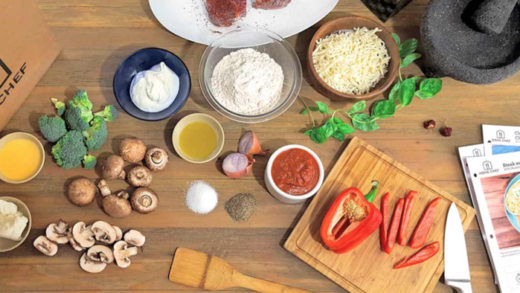Learn how to make beef tallow right in the comfort of your kitchen! If you are familiar with BBQ meats, you may have heard the term tallow, particularly in reference to smoked brisket. But what is tallow? Our informative guide will walk you through the ins and outs of this coveted beef fat, including how to source, prepare, store, and use it.

What is Tallow?
Beef tallow, or liquid gold, is simply rendered and purified beef fat. This type of fat is not to be confused with beef suet, which originates around organ meats, specifically the kidney area. Tallow is made of beef fat taken from the hard soap-like fat surrounding beef cuts like steak, brisket, roasts, and ribs.
Origins of beef tallow
The first mention of tallow dates back to the 15th century. It was extensively used as the primary “oleo” ingredient in baking, roasting, making candles, and even soap making. While this ingredient and other animal fats were eventually supplanted by butter and vegetable shortening, it has recently regained popularity, particularly in the BBQ community.
Other fats
Tallow is by no means the only form of animal fat used in food preparation. Pork fat, or lard, continues to appear in Southern regional cooking and Latin-American cuisine. Game fats such as goose and duck fat are used by professional chefs, Pitmasters, and home cooks worldwide.
What is rendered fat?
Rendering is a process used in the culinary world to transform animal tissue that is not commonly used into a usable, shelf-stable product. In this case, it involves melting beef fat at a low temperature of 130-140 degrees F. This process removes impurities and produces a clean lard-like substance that is safe to consume.
What does beef tallow taste like?
By now, you might be wondering what about the taste of beef tallow. Most of us have experienced that wonderful buttery-flavored, caramelized fat from beef briskets, beef ribs, and a perfectly cooked picanha steak. Well, rendered beef fat is slightly different. The flavor is actually unassuming, mellow, and subtle. The process of liquifying beef fat is different from searing a marbled steak or smoke cooking a brisket. First, the fat is not seasoned, and second, it is not rendered in a smoker or live fire setting. Its mellowness, among other attributes, contributes to its versatility and popularity. Due to its high smoke point, tallow is a great oil for deep frying foods like French fries. It was a cheap and quick alternative for fast food giants like McDonald’s, whose fries always had distinct crispiness to them.

Why is tallow popular in BBQ?
Pitmasters predominantly use tallow on smoked brisket. It also makes a great cooking oil, especially for cast-iron skillets steaks, and sauteing vegetables. Backyard cooks use beef tallow in one of two ways.
- Injection: Tallow is injected straight into the flat of a brisket to add flavor and moisture. The flat is most prone to drying out during long cooking times.
- Wrapping: Pitmasters also coat the brisket or butcher paper with tallow before wrapping the brisket and again during the resting period. Some BBQ restaurants lightly coat their sliced brisket during service. This is mostly done for presentation, as it glosses the surface of the meat, making it looks shiny and juicy.

Where to source tallow
You can source tallow in stores or online through multiple sources. It’s best to look for a good quality product such as 100% grass-fed beef or Wagyu tallow. Grain-fed beef fat is not the best to use, so be discerning when purchasing pre-made tallow.
Another option is to make your own. Remember that it can take some time to collect enough beef fat to make a few jars. You can start by placing the trimmings into an airtight container or a resealable plastic container. Once you’ve collected a good amount, you can make a batch or two.
Ingredients
- Grass fed beef fat: Raw beef fat trimmings from whole packer briskets, steaks, roasts, etc.
- A Slow-cooker or stock pot: The slow-cooker is a better option, but a large stockpot will do if you do not own one.
- Food processor: This is extremely helpful but not required.
- Mason jars or any other glass jar
- Fine mesh strainer: The first step to remove impurities
- Cheesecloth or coffee filters: a second step to remove impurities and refine the tallow.

How to make grass-fed beef tallow
There are two methods of making tallow, which include wet rendering and dry rendering. Wet rendering involves reducing the fat with water and salt, while dry rendering is melting just the fat over low heat. We will be using the dry rendering method for this recipe guide.
- Trim off any meaty bits and gristle from the fat from grass fed beef brisket. We want pure beef fat for this recipe, as other tissue will corrupt the finished product.
- Freeze the fat for 30-60 minutes. Skip this step if you’ve pre-frozen the tallow fat.
- Chop into smaller chunks and add them to your food processor, pulse until it takes on the appearance of crumbled feta. Depending on where you’ve sourced the fat, the color might be bright yellow or milky white.
- Place the fat inside your slow cooker (crockpot), secure the lid, and set it on very low heat. It should take roughly 4-5 hours to render fully, depending on the amount of fat used.
- During the end stage of the rendering process, the impurities will rise to the top. The liquid underneath will be clear and completely melted through.
- Strain the melted fat into a large bowl using a fine-mesh strainer. This will catch the larger impurities.
- Place a piece of cheesecloth (or coffee filters) over your mason jar. Pour rendered tallow into the jar. Repeat the process with subsequent jars.
- Use immediately, or allow the jars to cool. It will become a whitish-yellow color as it cools.
- Storage: Store on your countertop or pantry for several days, or place it into your fridge for 8-10 weeks.

Recipes that benefit from tallow
Smoked Beef Brisket
Sweet Potato Fries
Skillet Steak

- 3 pounds beef fat (grass-fed beef) trimmed
-
Trim off the meaty bits and gristle from the fat.
-
Freeze the fat for 30-60 minutes. If the fat has already been frozen, skip this step.
-
Chop into smaller chunks and add them to your food processor, pulse until it takes on the appearance of crumbled feta.
-
Place the fat inside your slow-cooker (crockpot), secure the lid, and set it on low. Cook for 4-5 hours.
-
During the end stages, the impurities will rise to the top. Once liquid beneath the impurities looks clear, your tallow is done.
-
Strain the melted fat into a large bowl using a fine-mesh strainer.
-
Now, place a cheesecloth (or coffee filters) over your mason jar. Pour the tallow into the jar. Repeat process with subsequent jars.
-
Use immediately, or allow the jars to cool. It will turn whitish-yellow color as it cools.
-
Store at room temperature on your countertop or pantry for several days, or place it into your refrigerator for 8-10 weeks.
Calories: 75kcal | Protein: 12g | Fat: 3g | Saturated Fat: 1g | Polyunsaturated Fat: 1g | Monounsaturated Fat: 1g | Trans Fat: 1g | Cholesterol: 34mg | Sodium: 36mg | Potassium: 188mg | Calcium: 5mg | Iron: 1mg
#Beef #Tallow




